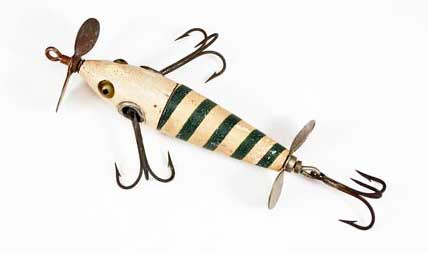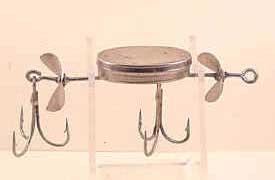
Have you ever stopped to consider the odd names given to lures or some of the techniques they’re used for? Some are so ridiculous and curious, it makes you wonder how they originated.
Take “doodle socking,” for instance. What was that guy thinking?
More than technique, I have a particular fascination with the names given to fishing lures, especially the really unusual ones. Old or new, uniquely named lures seems to grab my attention. And that, I’m sure, is what the manufacturer had in mind — the more identifiable the name, the better its chances for success.
Classic Names
Oftentimes, the best names are those that aptly describe a lure or the technique it’s intended for. Obviously there are exceptions, but it seems many of the classics tend to have classic names.
Take the Rat-L-Trap for example. Its name says it all. With this name, Bill Lewis launched a lipless crankbait craze that continues to this day. His lure is obviously great at catching fish, but the fact that its name is so unique and descriptive almost guaranteed its success.
Tackle companies spend thousands of dollars on names — acquiring, promoting and protecting them. It’s an important part of branding and it’s always been that way — even since the early 1900s when the American fishing tackle industry was getting established.
Heddon, Shakespeare, South Bend and other early manufacturers worked non-stop in developing new products to fool fish, and naming them was as important as producing them.
Over the years these companies tagged some great classics. Heddon, for instance, coined the Crazy Crawler, Lucky 13 (an obvious contradiction of terms), and S.O.S., which actually stood for Swims-On-Side. Shakespeare came up with the Revolution (a hollow-metal revolving lure), Jim Dandy and Tantilizer, to name a few. South Bend had the “Oreno” series, which included classics like the Truck-Oreno, Whirl-Oreno and Bass-Oreno.
Some of these say nothing about the lure’s design or other attributes or even how they were fished, yet their names stick in your head.
Pet Names and Names of Places
Here’s one for Dean Rojas: “Oscar the Frog.” In fact, Dean could have a field day when it comes to frog names. Artificial frogs have been produced for more than 100 years — even hollow-bodied rubber frogs have been around that long — and the names given them are limited only by the number of variations conceived.
Some are hilarious, others are strange. Like the Cool Ripple Frog, Feathered Frog (a frog with feathers?), Lim-Bo-Legs, Rhodes Mechanical Frog and my favorite, Francois the Frog. Frog lures are cute and deserving of names like these.
Many lure names were attributed to geographic locations, like the Jersey Wow, Florida Special, Michigan Life-Like, Erie Dearie and Catalina Minnow. There are nearly as many variations of these as there are places to fish them.
Fantastic and Imaginative Names
 One of the most imaginative names ever given to a lure was “The Charmer.” Made in 1910, this wooden bait featured counter-rotating props and a two-section lure body, the aft portion of which was painted with a spiral stripe. When the lure moved forward the tail section would spin, making the stripe spiral like a barber’s pole. That must have been the “charmer” part, because it’s absolutely mesmerizing to watch.
One of the most imaginative names ever given to a lure was “The Charmer.” Made in 1910, this wooden bait featured counter-rotating props and a two-section lure body, the aft portion of which was painted with a spiral stripe. When the lure moved forward the tail section would spin, making the stripe spiral like a barber’s pole. That must have been the “charmer” part, because it’s absolutely mesmerizing to watch.
Or how about Dr. Wasweyler’s Electric Glow Casting Bait or Payne’s Humane Woggle Bug or The Liar Convertible Minnow. I’m not sure what these names are trying to say, but I sure like them.
Novelty Names
Some names are just plain silly or lack imagination, yet they helped sell poorly designed products. Take the Bidwell Bottle Bait (c. 1915) for instance — an old wooden plug shaped like, you guessed it, a bottle.

Or, how about the old Scooter Pooper? One look at this contraption and you know it couldn’t have been very effective — it looks more like an old aspirin tin welded to a prop shaft than a fishing lure — sort of a poor man’s buzzbait. There’s no telling what the company had in mind. Surprisingly though, the name stuck and thousands were sold.
Contemporary Names
Not much has changed in centuries of lure making. Even today’s designers search for just the right monikers to title their creations. A quick look in any catalog will reveal a broad stroke of ideas that made it to market.
Gary Yamamoto hit a homerun with the Senko. Although it’s actually a Japanese term meaning flash, the name somehow fits and draws attention to the lure’s greatest attribute — how it sinks.
Zoom Bait Company brought it with the Horny Toad and Brush Hog. Reaction Innovations came up with a few doozies as well. They make great lures for sure, but most require at least a PG-13 rating.
One I’m particularly fond of is the HeadBanger, a buzzbait I designed for Hildebrandt. I can’t take credit for the name, however. That came from a sales rep who recognized the most important aspect of the lure’s design — the blade striking the head on rotation, which results a very loud clacking sound. I can’t imagine a better name for that one.
I’m sure you guys have your favorites too. It’s another aspect of our sport that we can all appreciate.
Nowadays, listening to tournament anglers describe the lures and techniques they use is a great source of entertainment, simply because of the odd names they mention. And when you consider what the casual non-fishing observer would think after hearing one of those spiels … well, we all look pretty silly, I’m sure.





